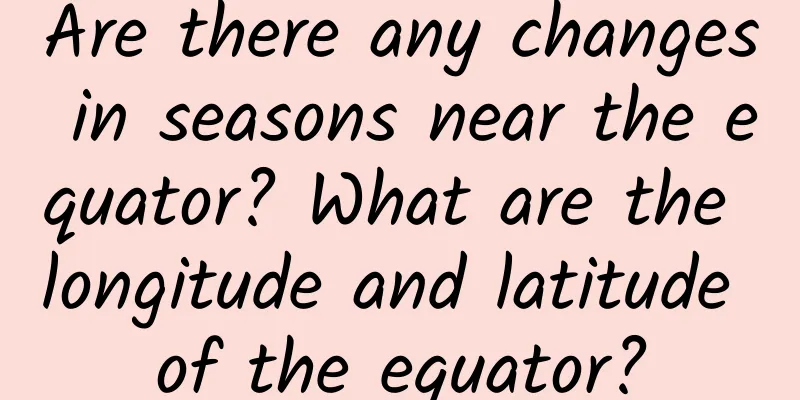Are there any changes in seasons near the equator? What are the longitude and latitude of the equator?

|
The equator is the dividing line between the northern and southern hemispheres, and is also the zero degree latitude line on the earth. It refers to the longest circumference of the trajectory of points on the earth's surface as the earth rotates. Many friends have learned these common sense but have not remembered them. Let's review these common sense about the equator today! Contents of this article 1. Are there any changes in seasons near the equator? 2. What are the longitude and latitude of the equator? 3. The descending node of the ecliptic to the equator 1Are there any changes in seasons near the equator?There are no four seasons, no wet or dry seasons, no wind (equatorial doldrums) near the equator (within 5° north and south latitude), and the weather is almost the same every day throughout the year. Of course, this is only in general, but the earth is too complex to be generalized. For example, the East African Plateau near the equator is affected by factors such as topography, so there is a difference between dry and wet seasons, but this is an individual phenomenon. Due to the high direct angle of the sun, the temperature in the equatorial region is higher throughout the year. However, due to the north-south movement of the sun's direct point, the climate zone shifts north and south, and the precipitation changes. The equatorial region is usually divided into two seasons based on the difference in precipitation, namely the rainy season and the dry season. It should be noted that the high temperature in the equatorial region is not caused by the "close distance" to the sun, but because the direct angle of the sun is higher than other parts of the earth. 2What is the equatorial latitude and longitude?The latitude of the equator is 0 degrees, and there is no accurate longitude. Because the equator is a circular line around the earth and has no fixed point, the longitude of the earth cannot be determined. The equator is the dividing line between the southern and northern hemispheres, and is also the zero degree latitude line on the earth. It refers to the circular line with the longest circumference in the trajectory of points on the earth's surface as the earth rotates. The equator is directly exposed to the sun twice a year, so the equatorial region is tropical, with hot weather and high temperatures all year round. The center of the equator coincides with the center of the earth, and it is also the longest latitude circle on the earth. The equator passes through many countries including Gabon, Congo, Zaire, Uganda, Kenya, Somalia, Maldives, Indonesia, Ecuador, Colombia and Brazil. The equator is a low-pressure area. The northeast trade winds and southeast trade winds blowing from both sides of the equator drive the sea water on both sides of the equator to flow from east to west. The northern one is called the North Equatorial Current, and the southern one is called the South Equatorial Current. 3The descending node of the ecliptic relative to the equatorThe descending intersection of the ecliptic with the equator is called the obliquity of the ecliptic, also known as the solar declination angle or the greatest elongation of the ecliptic. The obliquity of the ecliptic when the Earth revolves around the sun is approximately 23°26'. The existence of the obliquity of the ecliptic is the fundamental reason for the change of seasons and the distinction of five zones on Earth. The ancients called the sun's annual apparent orbit (that is, the reflection of the Earth's orbit on the celestial sphere) the ecliptic, which is the great circle where the Earth's orbital plane intersects the celestial sphere. The ecliptic and the equatorial plane intersect at the vernal equinox and the autumnal equinox. Since the Earth's rotation axis is not perpendicular to the orbital plane, the equatorial plane and the ecliptic plane do not coincide. The equator refers to the circular line with the longest circumference in the trajectory of a point on the earth's surface as the earth rotates. It is the dividing line between the southern hemisphere and the northern hemisphere. |
<<: What are the benefits of eating dried abalone? Is it better to have more dried abalone heads?
>>: I just realized today that every sip of probiotic drink I take is lonely...
Recommend
[Expert Science] A health killer that cannot be ignored - pulmonary embolism (I)
So what is pulmonary embolism? Pulmonary embolism...
Blood clots after taking mifepristone
If you accidentally get pregnant before marriage,...
Picture of fetus induced abortion at 18 weeks
At 18 weeks of pregnancy, the fetus is about 20 c...
Can I have sex with my wife when she is four months pregnant?
We all know that doctors do not recommend pregnan...
Ovulation bleeding pad is full of blood
Some women will experience bleeding during ovulat...
How many eggs does a woman lay in her lifetime?
Although they are women, many people still do not...
What causes chest pain after transplantation?
After the transplantation is successful, the trop...
My breasts swelled when my period came
Menstruation is a normal physiological cycle for ...
What causes acne at the vaginal opening?
With the rapid development of the economy, people...
How to clean small white shrimps? How to store small white shrimps
White shrimp, also known as spinal tail white shr...
Precautions for caesarean section belly band
Nowadays, many women choose to have a cesarean se...
What is prebiotics?
Yisheng Alkali is the flagship brand of Guangzhou...
Things to note 20 days after miscarriage
As people's work pressure increases in daily ...
Exploring the future of sleep: the revolution in bionic sleep technology
In the fast-paced modern life, sleep quality has ...









